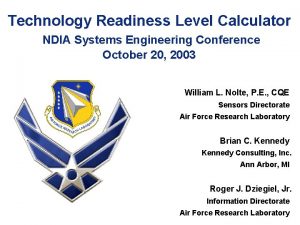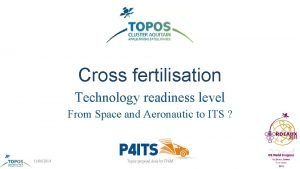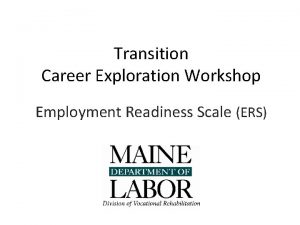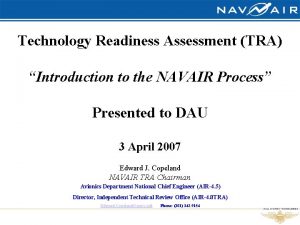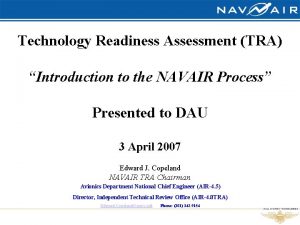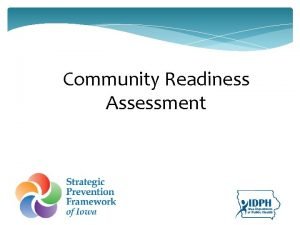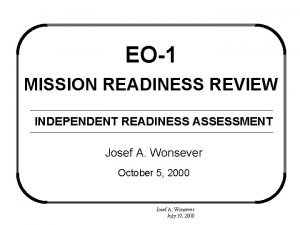Technology Readiness Assessment TRA Do D Requires all











- Slides: 11

Technology Readiness Assessment (TRA) • Do. D Requires all Major Defense Acquisition Programs to conduct a TRA prior to Engineering and Manufacturing Development (Milestone B) for review by ASD(R&E) • Do. D uses the TRA as the basis for certification to Congress • MDAs for all programs are required to ensure that technology risk has been reduced to acceptable levels prior to entering engineering development • ACAT II-IV programs should conduct TRAs by tailoring the TRA Guidance TRA Definition: Systematic, metrics-based process and accompanying report • Assesses the maturity of critical technologies used in systems • Uses Technology Readiness Level (TRL) as the metric – Adequate maturity at MS B (TRL 6 or greater) is largely based on experience with prototypes or previous usage in a relevant environment • Report includes – how the critical technologies are identified, 1 11 May–USD AT&L memo “Improving Technology Readiness Assessment Effectiveness” why critical technologies are important to the program, and

Technology Readiness Assessment (TRA) • TRA assesses the maturity of critical technologies – Uses Technology Readiness Level (TRL) as the metric – Adequate maturity at MS B (TRL 6 or greater) is largely based on experience with prototypes or previous usage in a relevant environment • New TRA guidance (April 2011 and May 2011) – Docs are on student CD-ROM (in “Technical Reviews” folder) – TRAs are now conducted & reported by the PM, using SMEs as appropriate – MDAPs must conduct a TRA prior to MS B, for review by ASD(R&E) – All programs - must insure that technology risk has been reduced to acceptable levels prior to entering EMD – ACAT II-IV programs should conduct TRAs by tailoring the TRA Guidance • TRA Report includes: – how the critical technologies are identified, 2

TRA Execution 1. Program identifies the critical technologies in the context of the program’s systems engineering process, based on a comprehensive review of the most current system performance and technical requirements and design and the program’s established technical work breakdown structure. 2. Data concerning the performance of the critical technologies are collected and presented to reviewers independent from the program and expert in the technologies 3. Independent reviewers assess maturity of critical technologies against established TRL metrics 4. PM prepares report and sends through PEO to the Component Acquisition Executive or Agency Head, who then transmits it to ASD(R&E) 5. ASD(R&E) reviews TRA plan and recommends any changes then provides the MDA an independent assessment and review concerning whether the technology in the program has been demonstrated in a relevant environment 6. A waiver by the MDA is possible, but this waiver must be based on acceptable means of risk mitigation, such as inclusion of an alternative more mature technology ASD(R&E) TRA Guidance, April 2011 3

Technology Readiness Assessment (Template) 1. 0 Purpose of Document 2. 0 Executive Summary 3. 0 Program Overview 3. 1 Program Objective 3. 2 Program Description 3. 3 System Description 4. 0 Technology Risks Summary and Readiness Assessment 4. 1 Process Description 4. 2 Identification of Technologies Assessed 4. 3 Assessment of Risks and Demonstration in a Relevant Environment 4. 3. 1 First Technology 4. 3. 2 Next Technology 5. 0 Summary ASD(R&E) TRA Guidance, April 2011 4

TRL Definitions TRL Definition Description 1 Basic principles Lowest level of technology observed and readiness. Scientific research reported. begins to be translated into applied research and development (R&D). Examples might include paper studies of a technology’s basic properties. 2 Technology concept and/or application formulated. Supporting Info. Published research that identifies the principles that underlie this technology. References to who, where, when. Invention begins. Once basic Publications or principles are observed, other references practical applications can be that out-line the invented. Applications are application being speculative, and there may be considered and no proof or detailed analysis to that provide 5 support the assumptions. analysis to support From Technology Readiness. Examples Assessment Guidance, 13 May 2011 are limited to ASD (R&E), the concept.

TRL Definitions TR L Definition Description Supporting Info. 3 Analytical and experimenta l critical function and/or characteristi c proof of concept. Active R&D is initiated. This includes analytical studies and laboratory studies to physically validate the analytical predictions of separate elements of the technology. Examples include components that are not yet integrated or representative. Results of laboratory tests performed to measure parameters of interest and comparison to analytical predictions for critical subsystems. References to who, where, and when these tests and comparisons were performed. 4 Component and/or breadboard validation in a laboratory Basic technological components are integrated to establish that they will work together. This is relatively “low fidelity” System concepts that have been considered and results from testing laboratory-scale breadboard(s). References to 6 who did this work and when.

TRL Definitions TR L Definitio n Description Supporting Info. 5 Compon ent and/or breadbo ard validation in a relevant environm ent. . Fidelity of breadboard technology increases significantly. The basic technological components are integrated with reasonably realistic supporting elements so they can be tested in a simulated environment. Examples include “highfidelity” laboratory integration of components. Results from testing laboratory breadboard system are integrated with other supporting elements in a simulated operational environment. How does the “relevant environment” differ from the expected operational environment? How do the test results compare with expectations? What problems, if any, were encountered? Was the breadboard system refined to more nearly match the expected system goals? 7

TRL Definitions TR L Definition Description Supporting Info. 6 System/su bsystem model or prototype demonstra tion in a relevant environme nt. Representative model or prototype system, which is well beyond that of TRL 5, is tested in a relevant environment. Represents a major step up in a technology’s demonstrated readiness. Examples include testing a prototype in a highfidelity laboratory environment or in a simulated operational environment. Results from laboratory testing of a proto-type system that is near the desired con-figuration in terms of performance, weight, and volume. How did the test environment differ from the operational environment? Who performed the tests? How did the test compare with expectations? What problems, if any, were encountered? What are/were the plans, options, or actions to resolve problems before moving to the next level? From Technology Readiness Assessment Guidance, ASD(R&E), 13 May 2011 8 Complete list at end of lesson

TRL Definitions TR L Definition Description Supporting Info. 6 System/su bsystem model or prototype demonstra tion in a relevant environme nt. Representative model or prototype system, which is well beyond that of TRL 5, is tested in a relevant environment. Represents a major step up in a technology’s demonstrated readiness. Examples include testing a prototype in a highfidelity laboratory environment or in a simulated operational environment. Results from laboratory testing of a proto-type system that is near the desired con-figuration in terms of performance, weight, and volume. How did the test environment differ from the operational environment? Who performed the tests? How did the test compare with expectations? What problems, if any, were encountered? What are/were the plans, options, or actions to resolve problems before moving to the next level? 9

TRL Definitions TRL Definitio n Description Supporting Info. 7 System prototype demonstr ation in an operation al environm ent. Prototype near or at planned operational system. Represents a major step up from TRL 6 by requiring demonstration of an actual system prototype in an operational environment (e. g. , in an air-craft, in a vehicle, or in space). Results from testing a prototype system in an operational environment. Who per-formed the tests? How did the test compare with expectations? What problems, if any, were encountered? What are/were the plans, options, or actions to resolve problems before moving to the next level? 10

TRL Definitions TR L Definition Description Supporting Info. 8 Actual system completed and qualified through test and demonstra tion. Technology has been proven to work in its final form and under expected conditions. In almost all cases, this TRL represents the end of true system development. Examples include developmental test and evaluation (DT&E) of the system in its intended weapon system to determine if it meets design specifications. Results of testing the system in its final configuration under the expected range of environmental conditions in which it will be expected to operate. Assessment of whether it will meet its operational requirements. What problems, if any, were encountered? What are/were the plans, options, or actions to resolve problems before finalizing the design? 9 Actual system proven through Actual application of the technology in its final form and under mission conditions, such as those OT&E reports. 11
 Trl meaning
Trl meaning What flexibility assessment requires a partner?
What flexibility assessment requires a partner? Afrl trl calculator
Afrl trl calculator Technology readiness level esa
Technology readiness level esa Employment readiness scale
Employment readiness scale Orca assessment
Orca assessment School readiness report template
School readiness report template Cloud readiness assessment report
Cloud readiness assessment report Business transformation readiness assessment
Business transformation readiness assessment Employment readiness scale assessment
Employment readiness scale assessment Workplace readiness skills
Workplace readiness skills Tasc readiness assessment
Tasc readiness assessment


